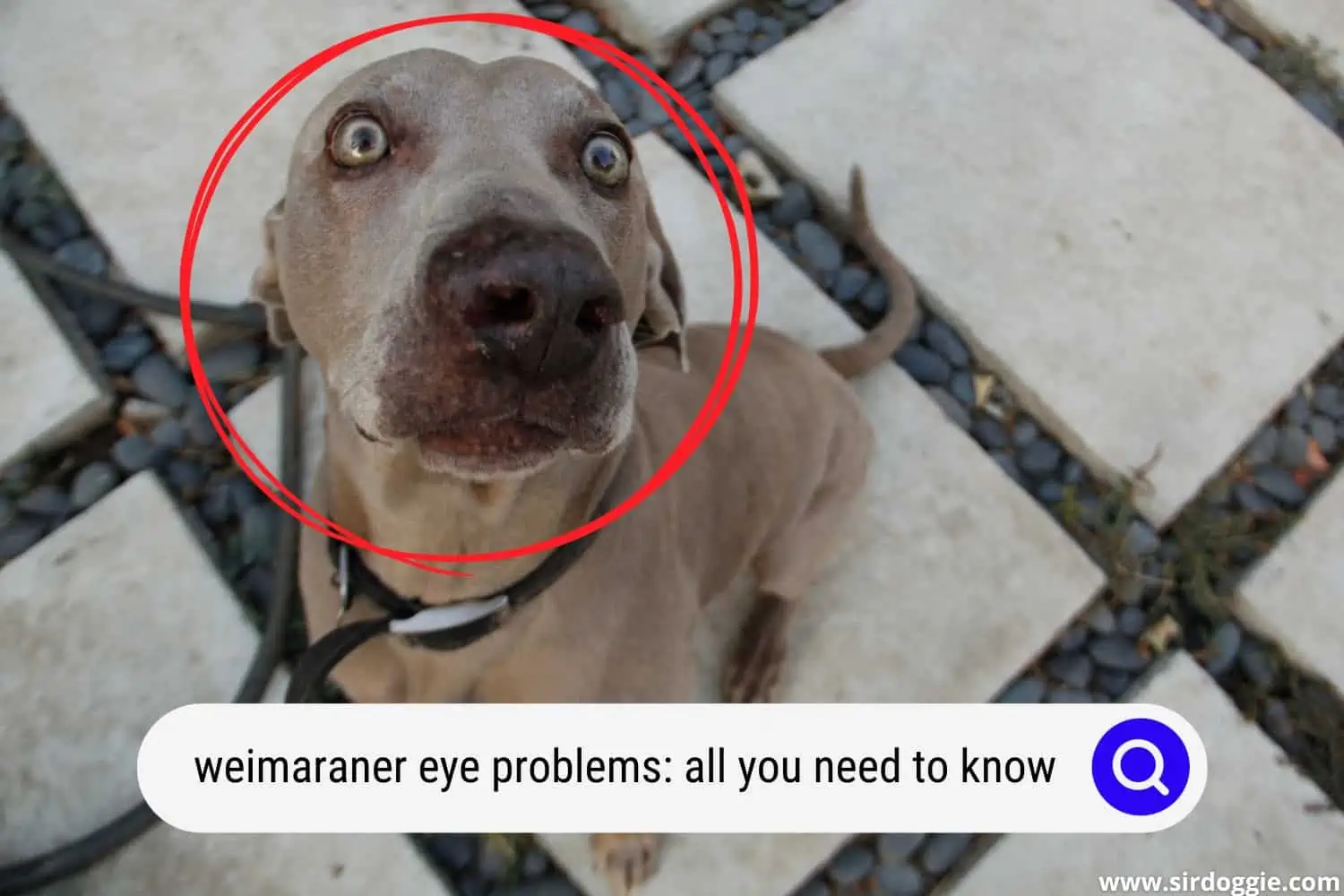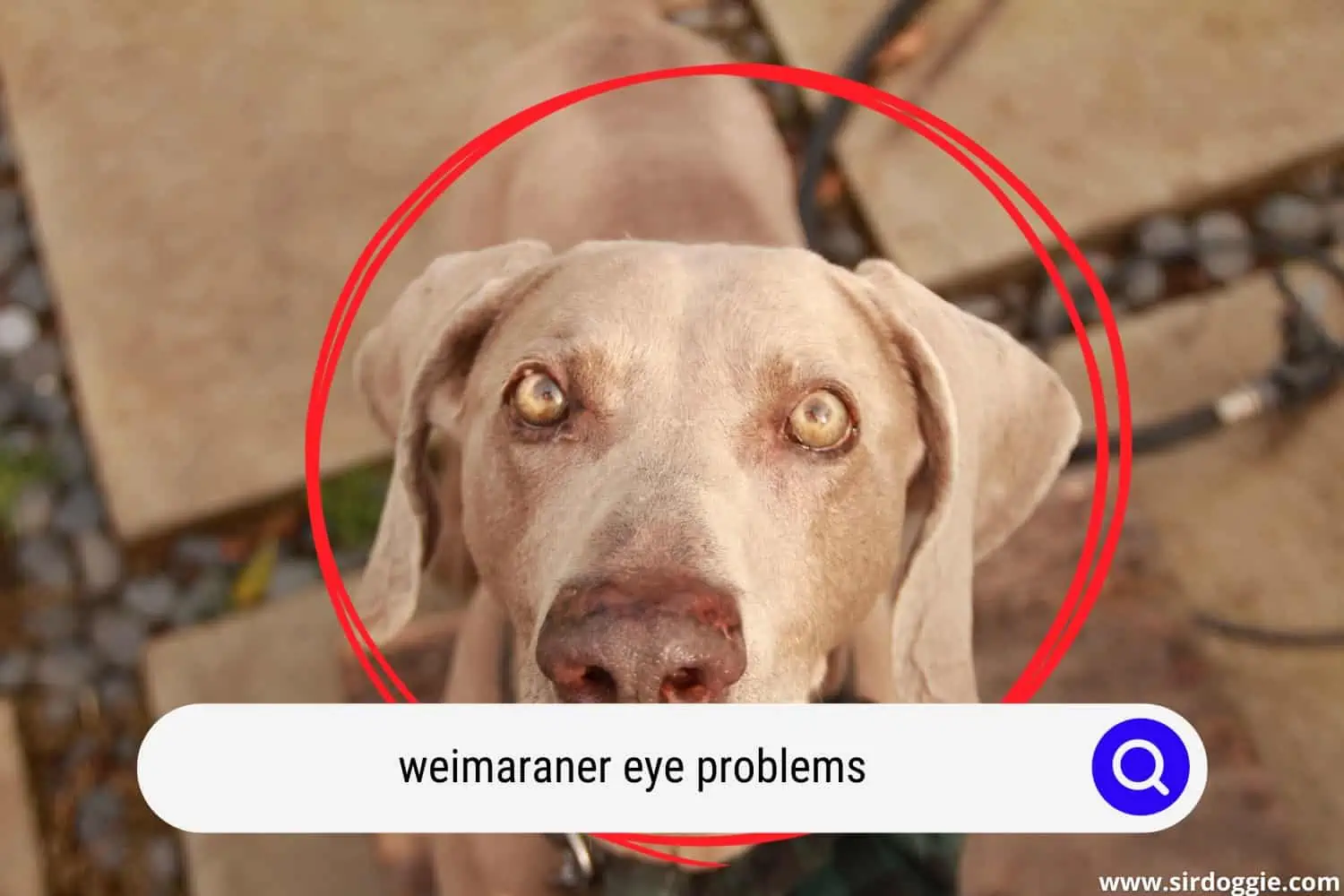All Weimaraner Eye Problems You Need to Know
The Weimaraner breed dog is known for having a sleek, shimmering gray coat and an exuberant personality. It is for this reason that the whole world knows this dog as the “gray ghost.”
Its eyes can be gray, blue-gray, or amber, and its gaze is captivating. However, such eyes are prone to health problems for the pet.

What are the Eye Diseases That Affect My Weimaraner Dog?
Entropion
Entropion occurs when the eyelid rolls inward, allowing the lashes to make physical contact with the cornea and cause irritation. If irritation continues without treatment, painful corneal ulceration will occur.
Entropion can affect the upper or lower eyelid of the Weimaraner and also one or both eyes.
It is usually seen within the first year of a dog’s life. That is due to a group of genes in the formation of the eyes and their surrounding structures, including the eyelids, the amount of facial tissue around the eyes, and the size and shape of the eyes and their orbits.
Some signs of Entropion include: squinting or blinking, yellow, white, or green eye discharge, eye inflammation, excessive tearing, etc.
Distichiasis
It is one of the most common congenital eye conditions in canines. This condition involves the growth of extra eyelash hairs in one of the eye’s glands, called the Meibomian gland, which causes irritation to the cornea.
This disease occurs in dogs under 3 years of age. As in the case of Entropion, untreated Distichiasis produces corneal ulceration. Signs that your Weimaraner may have this condition include squinting or blinking and excessive tearing.
Treatment of Distichiasis consists of destroying the extra hair follicles so that they do not grow back. The vet will employ one of three methods to accomplish this:
- Electrolysis.
- Surgical removal.
- Cryosurgery, freezes the follicles at the margin from which they are growing.
Nictitating Membrane Abnormalities
Your dog’s third or inner eyelid is called the nictitating membrane. Two abnormalities that occur in the nictitating membrane can affect Weimaraners:
Cherry Eye
It happens when the tear gland prolapses and appears as a red bump in the corner of the dog’s eye.
Eversion of the Cartilage of the Nictitating Membrane
It occurs when the cartilage curves outward from the dog’s eye.
These abnormalities are inherited diseases. These two conditions are easily diagnosed by a physical eye exam, and both are often treated with surgery.
What can happen in the worst case? If either of these two conditions is not treated, dry eye will occur in the canine.
Corneal Dystrophy
Three types of corneal dystrophy occur from genetic eye disease.
The three types are called epithelial, endothelial, and stromal. All refer to a structural abnormality or degeneration of the cornea or corneal lining of the animal.
Corneal dystrophy can occur at any age in your puppy and generally affects both of its eyes.
This disease presents as cloudy areas in the eyes. These opaque areas are actually mineral deposits of cholesterol or calcium. Additional signs that can be observed include:
- Swelling of the cornea.
- Corneal spasms.
- Some visual impairment (in advanced cases).
Although corneal dystrophy may seem unpleasant, the condition rarely causes total blindness. If you notice symptoms, have your vet examine your Weimaraner’s eyes.
The exam will include a test in which a fluorescent dye is placed in the dog’s eyes, and the corneas are examined with blue light for ulcerations.
Your veterinarian may send your Weimaraner to a certified veterinary ophthalmologist for further evaluation or treatment. Some treatment options include:
- Dietary management to reduce cholesterol levels.
- Topical acid dissolution of mineral deposits in the cornea.
- Surgical intervention to remove the outer layer of the cornea. This procedure is generally referred to as a keratectomy.
- Topical ophthalmic medications.
Progressive Retinal Atrophy
The degenerative condition called progressive retinal atrophy is genetic. That arises when the light receptors in the Weimaraner’s retina begin to degenerate prematurely. Once this disease progresses, the result of progressive retinal atrophy is blindness. There is no pain associated with this condition. Signs of progressive retinal atrophy include:
- Formation of cataracts in the dog.
- Reluctance to go outside at night or move indoors during hours of darkness.
- Enlargement of the pupils of the canine.
- The gradual decrease in vision during daylight hours.
Progressive retinal atrophy can be diagnosed by an eye exam that includes electroretinography, which assesses the retina’s function.
Unfortunately, progressive retinal atrophy cannot be treated. You can take some comfort in the fact that blind dogs do well in their home environment.
If you are considering bringing a Weimaraner puppy into your home, we recommend that you speak with its breeder about all these genetic eye conditions in the canine.
Related Reading: What Do Weimaraners Die Of?

Recommendations to Avoid Eye Diseases in My Weimaraner Dog
First of all, before any symptoms of any of these diseases in your pet, it is always necessary to go to the vet to diagnose the type of condition and the appropriate treatment to eradicate it. You should never medicate your canine by choice, as it can turn out to be a delicate situation.
It is important to frequently clean the dog’s eyes with sterile gauze and physiological saline (never with chamomile infusion) to remove the eyes’ crusting and accumulated dirt.
It’s also a good idea to cut your Weimaraner’s hair around the eye area to prevent dirt accumulating on it from getting into the eye and causing damage.
Feeding your Weimaraner dog a balanced and quality diet that strengthens its immune system will help avoid these types of situations.

Family Dog Expert Author
Hi there! I’m Stuart, a devoted dog lover and family dog expert with over a decade of experience working with our furry companions. My passion for dogs drives me to share my knowledge and expertise, helping families build strong, loving bonds with their four-legged friends. When I’m not writing for SirDoggie, you’ll find me hiking, playing with my beautiful dog, or studying music.